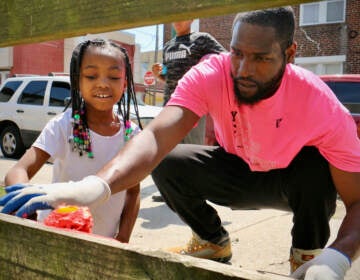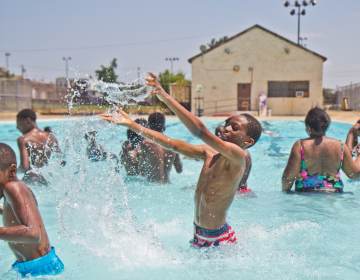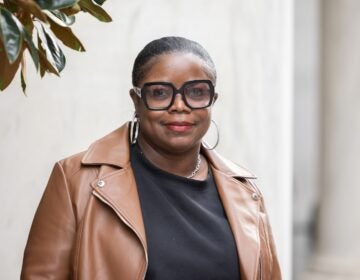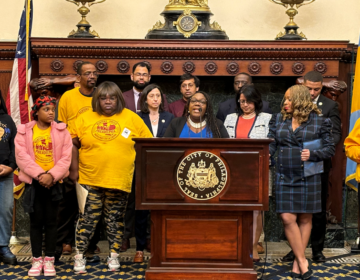Philadelphia police ask for $24 million boost in next year’s budget, citing gun violence prevention efforts
Some City Council members and community advocates say the money should be used to expand community policing efforts.
Listen 1:52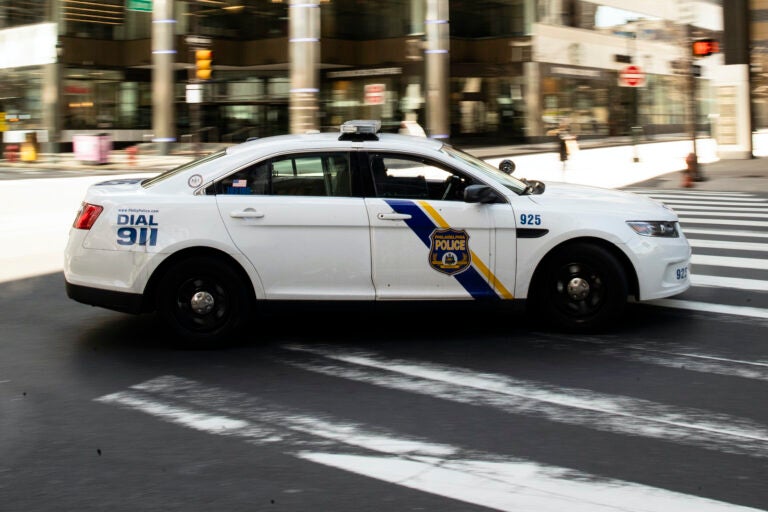
File photo: A police car drives in Philadelphia, Tuesday, March 24, 2020. (AP Photo/Matt Rourke)
At a budget hearing Tuesday, the Philadelphia Police Department presented a budget request to City Council: an additional $23.7 million to keep communities safe.
The police budget has grown substantially since 2013. Homicides have risen steadily during that same period, leading to criticism from community members and suggestions that funding be shifted toward social services and other violence prevention measures.
The proposed 2023 police funding allotment would mostly go toward payroll increases, with some money set aside for uniforms and supplies. The department plans to hire for eight new positions. Their total ask is close to $782 million, compared to roughly $758 million in 2022.
Council members Tuesday pushed Police Commissioner Danielle Outlaw for specifics on the department’s plans to reduce the number of shootings in the city, citing a looming summer spike in violence and a fear that 2022’s death toll will surpass the 562 homicides Philadelphia saw last year.
“What are we doing here?” asked Council President Darrell Clarke. “What are we doing on the broader scale to bring these numbers down, tamp them down, and create a different environment here?”
Outlaw highlighted Operation Pinpoint, which launched in 2019 with the goal of reducing gun violence in areas identified as being at high risk for shootings.
“It’s typically cops on dots,” she said. “It’s putting cops in areas that are the most problematic and as we move into spring and summer when school lets out, making sure we have visibility at our recreation centers, our commercial corridors.”
But residents in areas affected by gun violence say they aren’t seeing the type of community policing they feel would prevent shootings.
“I’ll see them sit in a car,” said Nicetown block captain Gilbert Coleman. “I don’t see them patrolling the community or taking a look to see what’s really going on … 50 feet, 100 feet away there’s activities which the police should be involved in.”
Coleman says if officers are out on foot or on bikes, interacting with residents as they survey the area, it could restore a sense of lawfulness.
The strategy Coleman is calling for is sometimes referred to as “community policing,” and it aims to build trust between residents and officers. There’s a mixed bag of research on whether hiring more cops to walk their beats makes a city safer, and many experts argue there are better ways to reduce gun crime. But the call for at least more engagement from officers – if not more physical officers – is a common one in Philadelphia’s gun violence prevention circles.
Councilmember Cherelle Parker brought up the strategy Tuesday.
“I am unapologetic about affirming that community policing in a proactive manner is the hallmark of this plan,” she said. “Residents in the city of Philadelphia deserve to see a proactive law enforcement presence in their neighborhoods that is not there because they are simply responding to crime.”
Police Deputy Commissioner Joel Dales said there are currently 100 officers on bikes and 60 officers on foot, but expects those numbers will increase as the weather warms.
He also voiced concerns that increasing foot controls would stretch the force too thin.
“That’s gonna have an effect on response time to calls for services, emergency calls,” he said. “We balance this out.”
Outlaw said some of the requested funding is for the mobility project, which she said will give officers the technology to perform more tasks while on foot.
“To get everything the officers need at their fingertips, so they can stay out in those areas and not have to get back in their vehicles, run a name, do whatever it is.”
Hearing attendees asked police department representatives about street cleanup, camera installation, drug crime enforcement, community evening resource centers and other efforts to make neighborhoods cleaner and safer.
Gun violence prevention advocates have called on law enforcement to do a better job finding and arresting shooters, both in homicides and nonfatal shootings.
Coleman, of Nicetown, said there are too many people committing crimes without consequences.
“They just feel as though they own the streets now,” he said. “It doesn’t belong to the community, it belongs to them.”
Councilmember Cindy Bass echoed community calls to crack down on perpetrators of gun violence.
“A lot of folks are feeling as if there’s a revolving door,” she said. “There are a lot of people on the streets who shouldn’t be on the streets … there can be no question that we have some very dangerous people out there.”
Commissioner Outlaw says the clearance rate for non-fatal shootings has grown to roughly 29% since the establishment of a non-fatal shootings unit at the beginning of this year. That clearance rate was 19% in 2020, according to data from the Office of the Controller.
In 2020 police cleared 37% of fatal shooting cases – a number the police department says is now around 50%.
WHYY is your source for fact-based, in-depth journalism and information. As a nonprofit organization, we rely on financial support from readers like you. Please give today.


